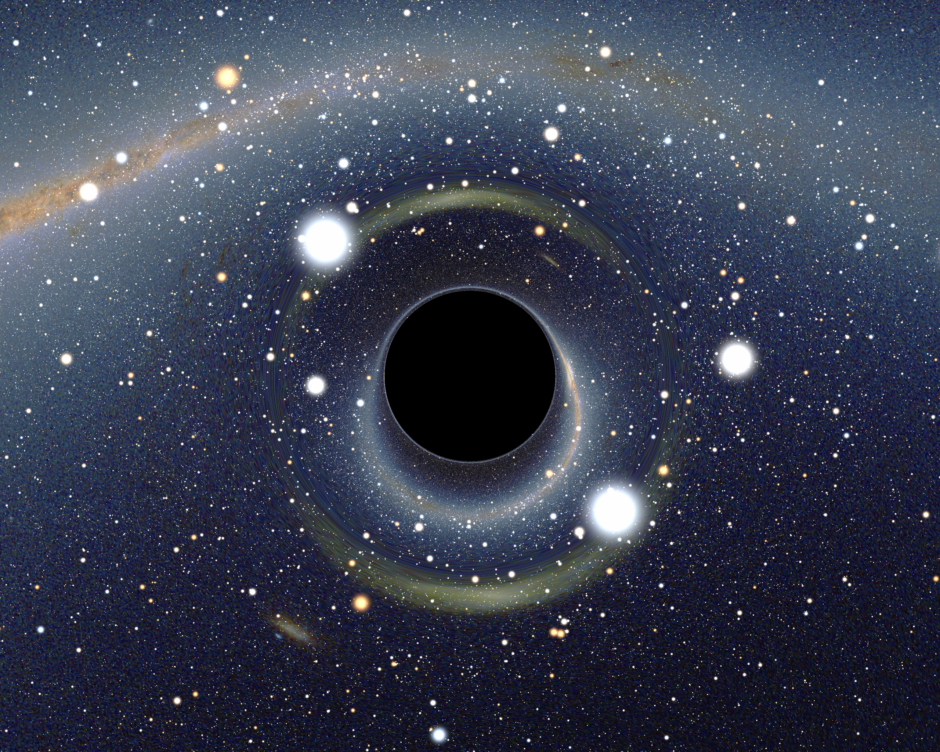Every living thing on our Earth has to thank the Sun for its ability to survive, as it warms the Earth to liveable temperatures. It is hard for us to imagine how a civilization could function without a star shining bright in the sky of its host planet.
Scientists in the Czech Republic have been researching if a planet could harness enough energy to run a civilization if the planet were orbiting a black hole instead of a star. This would work in a fundamentally different way than how our planet and civilization work. The sun emits light and UV-radiation, the type of sunshine that causes a sunburn. This light and radiation carry energy that gets used by things like plants and solar panels. Black holes don’t produce light1, hence the name black holes, but they have mind-boggling amounts of gravity, enough to attract light and radiation.
There are two phenomena that work together to allow a planet around a black hole to get power and heat. First, the universe has a bit of radiation in it already. This radiation keeps the void of space at 2.7 K, or -454 degrees Fahrenheit. This is cold by human standards, however, it is still warm enough to provide energy. A black hole can be massive enough to attract a large amount of this background radiation. Therefore, a planet orbiting the black hole would also be orbiting through radiation and would warm up the planet slightly.
The second phenomenon is due to relativity. When a loud ambulance rushes by, you hear a change in pitch of the siren due to the Doppler effect. This is actually caused by a change in wavelength of the sound that is caused by the movement of the ambulance. The same effect happens to light. The enormous gravity of the black hole causes the light to Doppler shift. In the instance of the planet in a black hole, the light is “blue-shifted” meaning the wavelength gets shorter, equivalent to the pitch of the ambulance getting higher. For light and radiation, blue-shifting increases the energy, and thus provides more heat to the planet.
These two phenomena, the blue-shifting of radiation and the concentration around the black hole, mean that a planet orbiting a black hole collects a large amount high-energy radiation.
The scientists researched in depth to see if these phenomenons would be enough to support a civilization on this planet. They first modeled an Earth-sized planet around a Sun-sized black hole. From this, they saw that this planet around this black hole would not gather enough power to sustain a civilization. This planet would collect 910 watts, which is only enough to power 15 light bulbs.
Researchers repeated the model around a much larger black hole, one that would appear to take up a third of the sky, but it still did not gather enough power. This Earth-sized planet gathered 19 megawatts of power, enough to power 4000 houses. By allowing this theoretical planet to orbit faster around the black hole, they increased the blueshift phenomenon and found the power to be about 200 megawatts, which is about 20% of the production of 1 coal power plant.
Next they had the planet orbit a “rotating black hole,” causing high gravity pockets to form around the black hole. This increases the blue-shift effect and brings in more power to the planet. Such a planet would receive 6.7 gigawatts of power! This is still much lower than our civilization, but is comparable to power consumption of a country, which could sustain a small civilization.
For their fourth experiment, these scientists were inspired by the movie Interstellar. In this movie, there is a planet that is so near the black hole, that the black hole takes up 40% of the sky on the planet! In this analogy, the amount of background radiation the planet would receive would be 411 terawatts. This is about 100 times less than what the Earth receives, but is starting to be enough to power a reasonably small civilization! This is an exciting result. However, the concentration of radiation on the surface of the planet would be 300 times as much uv-radiation as a standard Earth sunburn, and the surface of this unlivable planet would boil to hot 1630 degrees fahrenheit!
Last, the scientists imagined that a civilization built a Dyson sphere, a spherical arrangement of solar panels for capturing energy, around the black hole. Except, instead of collecting the light and radiation emitting from the star, it’d be collecting the background radiation being sucked in by the black hole. A Dyson sphere built around a black hole with the same mass as our sun would collect about a puny, 250 watts. However, if we assumed a younger universe, when the vacuum of space was room temperature, then we get an amazing result: such a Dyson sphere in this early universe would collect 3 times the power consumption of the Earth!
This study showed that it is possible from an energy & power standpoint to sustain a clever civilization. This is an important study for our search for intelligence in the universe. This is also interesting because our sun has a limited lifetime, so researching energy alternatives for sustaining life is an important part of keeping human civilization around beyond the lifetime of our star.
1. Technically, black holes do radiate some form of radiation but very, very, very little of it; research “Hawking Radiation” if you’re curious about black holes radiating.


